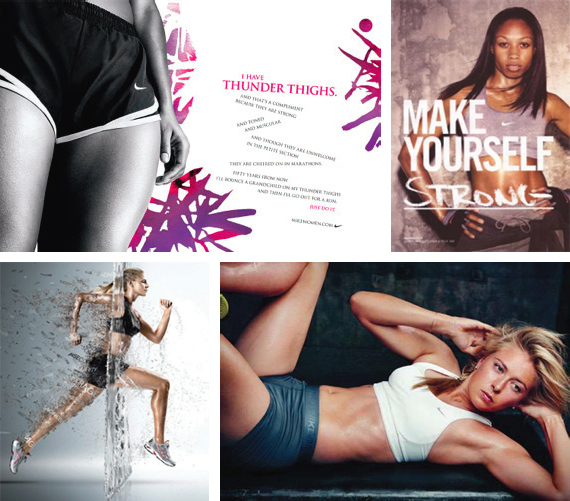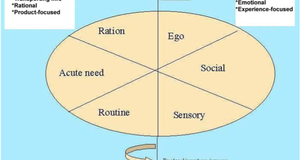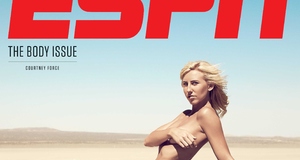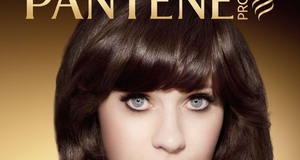From Elon Journal of Undergraduate Research in Communications VOL. 6 NO. 2Psychological Effects of Fitness Advertising on Female Collegiate AthletesSexualizing the Female Athlete in AdvertisementsWhile many fitness advertisers focus on the effects that exercise has on the physical appearance of the body, female collegiate athletes are more motivated by how their bodies perform than what their bodies look like (Heinecken, 2013). Advertisement #4 received the most negative responses of the advertisements shown during the focus group study. Although the fitness model was performing an abdominal exercise in the advertisement, participants felt that her facial expression, lack of clothing, and angle of the photograph all contributed to a "sexualized" image. One participant's first impression was that the advertisement "seems to promote sex appeal more than the personal desire to better yourself." Many found it hard to believe the model was really working out. Participants could not relate to the advertisement because most believed the model didn't look like she was exercising. For example, the model's hair in Advertisement #4 looked professionally done, while female athletes usually put their hair up during a workout. As one participant mentioned, "The ad was a little too ‘modely' to seem athletic. I mean, who works out with their hair down?" Another participant said, "I feel like this ad isn't for me." She did not feel connected to the advertisement because she thought it was targeted more for men to admire than for women to admire. According to participants, the model looked strong and physically fit, but they also thought that it was impossible to achieve her body, making the advertisement unrealistic. Telling Relatable Stories Through Fitness AdvertisementsPrint advertisements with a story resonated most with focus group participants. Advertisement #1 included copy that promotes positive body image by creating a relatable story of a runner who embraces her "Thunder Thighs." Many participants appreciated the empowering message. For example, one of them wrote, "I love the athletic build and the message that goes with it. It really seems to promote stability in the body rather than minimizing space." Although most participants reacted positively to Advertisement #1, some couldn't relate to the ad. "I like that it takes pride in something that is usually unwanted because everyone seems to strive for a thigh gap but this ad embraces larger thighs, which probably helps give girls confidence." "The ad tells a relatable story. I think it's a little sassy, but it works with their goal." Feeling a disconnect between the athlete's personal lives and the story told in Advertisement #1, the participants were not personally impacted by the message, although they acknowledged the probability that some women find the story relatable. Advertisement #3, however, told a story that was relatable to female athletes and runners, specifically. They understood the woman's struggles and the benefits that running provides physically and psychologically. "I liked it a lot . . . . I thought it was unique because it related to me as a person . . . . It was interesting and very creative." "That was my favorite ad. I love running because I run when I'm stressed, so the ad relates to me." "I like this naturally because I'm a runner. It should motivate people to run and shows that benefits go further than physical ones." Fitness Advertising and its Effects on Body ImageThe focus group participants all had different views and perceptions of their own bodies. Some felt more content than the average person. One participant said, "I rely on my abilities as a runner to feel good about my body image." Others expressed difficulty managing a positive body image as an athlete. Another participant responded, "I think because we're so competitive . . . you're going to be harder on yourself for your own self image. Athletes are more in tune with their bodies because you're constantly comparing yourself to other athletes in your own sport." Two track runners also described their conversations during practice: "Every day during warm up, we complain about our legs being too thick, our legs being too strong . . . . You want to be muscular, but at the same time you don't want to look too thick." Despite the various perceptions of self-image, the athletes all agreed that fitness advertising showed a lack of diversity in regard to body shape and size. The words "skinny," "tiny" and "fit" were used to describe the kinds of bodies they saw in fitness advertisements. Participants also mentioned that athletes have so many different, successful body types, but only one type of body is portrayed in the media. "Track has so many different body types within one team. You've got the distance girls, who are tiny, but you've also got the throwers who are so strong . . . . They don't depict that in ads though." As runners, some participants received pressure from parents and coaches to look a certain way. One athlete described how her father's perception was skewed by the media of what runners should look like and pressured her to look like a stereotypical athlete: "A lot of what I hear from [sic] my sport is from my dad, who has definitely only been revealed to the sport through magazines such as ‘Runners World' . . . . He has this concrete view of what a successful runner should be and should look like. I think the way media portrays us, it just really hammers it in him, and I still get that pressure from him." The focus group participants would rather see advertisements that show a variety of different body types in order to be inclusive to all athletes. "I appreciate seeing different body types and the athletic looking person versus the stereotypical model when modeling athletic clothes." "It'd be cool to see an ad with a team showing all different body types. The muscular build, the smaller build . . . and they're all successful. That'd be really cool." V. ConclusionsAccording to the study done by Grau, Roselli, and Taylor (2012), male athletes are portrayed far more frequently than female athletes in sport advertising. When prompted about fitness advertising, the female athlete participants in this study immediately thought of athletic men and were disappointed at the lack of female athletes shown in the media. To them, advertisements featuring men are not effective because those advertisements aren't relatable; therefore, they ignore those types of advertisements. Participants also responded negatively to sexualized advertisements, believing that the sexualized and posed images of models were "unrealistic" and ineffective. These responses are in line with what Heinecken found in his study, where Division I athletes responded negatively to sexualized and glamorized images (2013). That professional male athletes are seen more in advertising than professional female athletes, according to the analysis of Grau, Roselli and Taylor (2012), "may pose a potential problem with specific audiences, such as teens and fitness buffs, both of whom are not exposed to many female athlete endorsers in magazines" (p. 58). What they failed to discover is that a female athlete endorser is not enough to be resonating with another group of consumers, such as professional athletes. While featuring a female professional athlete is a step in the right direction, this study revealed that a realistic portrayal of the athlete is needed to appeal to female athletic consumers. For example, the Allyson Felix advertisement was not resonating with the female participants because she was posing like a regular model instead of what she's known for, a heroic athlete, even though she is a professional track athlete. To effectively evoke positive emotions from female collegiate athletes, an advertisement should tell a realistic story that is relatable to athletes. Female athletes lose focus on fitness advertisements that look posed or unnatural. They want to see a real athlete going through the same struggles and successes that they face every day. Achieving the "perfect" body is not a goal for a female Division I athlete. Her goal is to use her body to perform well in her sport, regardless of whether it looks physically appealing. While it is important to show realistic body types, female collegiate athletes want to see athletes who are successful, regardless of their body shape and size. Based on the participants' reactions to different fitness advertisements, this study also demonstrated that athletic ability is more important to athletes than physical appearance. Female athletes relate to stories that are about performance and benefits of exercise than stories about celebrating physical appearance, which is why they responded more positively to Advertisement #3 than Advertisement #1. Picturing a successful college team in an ad would not only promote athletic achievement, but it would also show the many different body types that can be successful in a sport. Limitations and Further ResearchWhile this study revealed some perceptions of fitness advertising on female collegiate athletes, more research needs to be conducted to further test the findings. The focus group, which consisted of 11 college females who competed in the same sport, is not large enough to make a generalization to all female collegiate athletes. Also, many external factors could influence their perceptions of advertisements, such as family life or levels of self-esteem. Further research could be conducted with female athletes from other sports or from diverse universities, using more variables, including participants' self-esteem or family background. AcknowledgmentsThis author would like to extend many thanks to Glenn Scott, associate professor of communications at Elon University, for his guidance, encouragement, and dedication to the study, without which the article could not have been published. The author also appreciates the help of the Elon University women's cross country and track teams for their voluntary efforts and support throughout the research process. AuthorJenny Gallagher, Strategic Communications, Elon University ReferencesBissell, K. L. (2004). Sports model/sports mind: the relationship between entertainment and sports media exposure, sports participation, and body image distortion in Division 1 female athletes. Mass Communication & Society, 7(4), 453-472. Bissell, K., & Birchall, K. (2007). Playing like a girl: perceived influence of the media & parents and body self-esteem in adolescent female athletes. Conference Papers -International Communication Association. Grau, S., Roselli, G., & Taylor, C. R. (2007). Where's Tamika Catchings? A content analysis of female athlete endorsers in magazine advertisements. Journal of Current Issues & Research In Advertising (CTC Press), 29(1), 55-65 Heinecken, D. (2013). Fit for everything. Feminist Media Studies, 13(1), 29-45 Horne, J. (2006). Sport in consumer culture. New York, NY: Palgrave MacMillan. Houlihan, B. (2003). Sport & Society: A Student Introduction. Thousand Oaks: Sage. Jackson, S. J., & Andrews, D.L. (2005). Sport, Culture and Advertising: Identities, Commodities and the Politics of Representation. New York, NY: Routledge. Jardine, A. (2014, September 04). Gisele Bundchen shows off some serious toughness for Under Armour. Ad Age. Retrieved from http://adage.com/article/creativity-news/gisele-bundchen-plays-tougharmour/ 294820/ Peetz, T. B. (2002). Sport heroes as product endorsers: The role of gender in the transfer of meaning process. Microform Publications Bulletin: Health, Physical Education and Recreation.Exercise and Sport Sciences, 15(2), 126. Retrieved from https://ezproxy.elon.edu/login?url=http://search.proquest.com/docview/18716190?accountid=10730 Rosenberry, J., & Vicker, L. A. (2009). Applied mass communication theory: A guide for media practitioners. Boston, MA: Pearson Education, Inc. Smith, L. R. (2011, May 25). Shoot, score, strip? Media representations of female athletes and their impact on collegiate athletes. Paper presented at the annual meeting of the International Communication Association, TBA, Boston, MA Online. 2014-11-10 from http://citation.allacademic.com/meta/p490183_index.html Appendix AModerator GuideMedia & Advertisements (5 minutes)
Sport Brands and Purchasing Power (15-20 minutes)
Perception of Sport Advertisements (25-30 minutes) For this exercise, I'm going to show four print advertisements and one commercial. I want you to write down your initial thoughts and feelings of each one. Write down anything that comes to mind: how you feel, what stands out, what you like, what you don't like.
Motivating Factors in Advertisements (10 minutes)
Closing (5 minutes)
Suggested Reading from Inquiries Journal
Inquiries Journal provides undergraduate and graduate students around the world a platform for the wide dissemination of academic work over a range of core disciplines. Representing the work of students from hundreds of institutions around the globe, Inquiries Journal's large database of academic articles is completely free. Learn more | Blog | Submit Latest in Psychology |





















